AI Bot Implementation & Optimization Checklist
Implementing and optimizing an AI bot requires a clear plan, the right tools, and ongoing refinement. Whether you are a developer building custom solutions, a business seeking to enhance customer engagement, or an AI enthusiast exploring new technologies, this checklist will guide you through each phase of the process—from initial strategy to long-term maintenance.
5/16/20251 min read


Planning & Strategy
Define the bot’s primary purpose (customer support, lead generation, process automation, etc.)
Establish key performance indicators (KPIs) such as response accuracy, resolution time, and user satisfaction
Choose an architecture: rule-based, NLP-driven (e.g., ChatGPT), or a hybrid approach
Verify compliance with data privacy regulations (GDPR, CCPA, and other relevant standards)
Development & Integration
Select an appropriate platform or framework (Dialogflow, Rasa, OpenAI API, etc.)
Design conversational flows and map user intents to actions
Integrate the bot with backend systems (CRM, ERP, RESTful APIs, databases)
Implement fallback and escalation logic for unrecognized queries
User Experience & Design
Optimize natural language understanding (NLU) for context and intent recognition
Personalize interactions using available user data (purchase history, account details)
Ensure compatibility across channels (website chat, WhatsApp, Telegram, mobile apps)
Provide seamless handover to human agents when needed
Testing & Deployment
Conduct A/B testing on different response variations to identify the most effective approaches
Test edge cases and invalid inputs to ensure robust error handling
Monitor performance metrics such as latency and comprehension accuracy
Roll out in phases—start with a controlled beta launch before full deployment
Monitoring & Optimization
Track KPIs continuously (engagement rate, resolution rate, user feedback scores)
Leverage analytics tools (Google Analytics, chatbot log analysis) to gain insights
Regularly retrain the model on fresh conversational data
Solicit user feedback and iterate on the bot’s design and responses
Security & Maintenance
Encrypt all sensitive data in transit and at rest
Apply security patches and framework updates promptly
Back up conversation logs and training datasets on a regular schedule
Retrain and fine-tune models periodically to prevent performance degradation
Pro Tips for TechMoneyAI Readers
Developers: Experiment with fine-tuning open-source large language models (e.g., Llama 2) for industry-specific use cases.
Businesses: Consider a hybrid deployment that blends automated workflows with live agent support to ease the transition.
Beginners: Start with no-code chatbot platforms like Botpress or ManyChat to prototype ideas before committing to full development.
